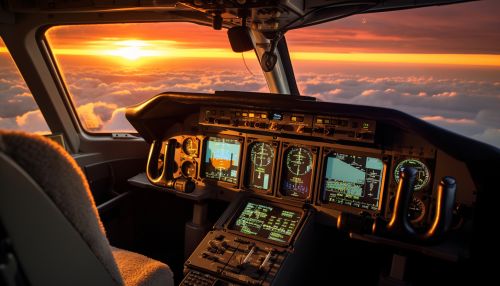Radio Navigation
Introduction
Radio navigation is a field of study and application that focuses on the use of radio frequencies to determine a position of an object on the Earth's surface. This is achieved through the use of radio waves, which are electromagnetic waves with frequencies ranging from 3 kHz to 300 GHz.


History
The concept of radio navigation can be traced back to the early 20th century. The first practical radio navigation system, known as the Lorenz system, was developed in Germany in the 1930s. This system was primarily used for aircraft navigation.
Radio navigation relies on the principles of radio wave propagation, which refers to the way radio waves travel or spread out from one point to another. There are several key principles that underpin radio navigation.
Time of Arrival
The Time of Arrival (TOA) principle involves determining the distance between a transmitter and a receiver by measuring the time it takes for a radio wave to travel from the transmitter to the receiver.
Angle of Arrival
The Angle of Arrival (AOA) principle involves determining the direction of a radio wave source by measuring the angle at which the wave arrives at a receiver.
Differential Time of Arrival
The Differential Time of Arrival (DTOA) principle involves determining the position of a radio wave source by measuring the difference in arrival times of the wave at two or more receivers.
There are several types of radio navigation systems, each with its own unique characteristics and applications.
Terrestrial Systems
Terrestrial radio navigation systems, such as Loran-C, use ground-based transmitters. These systems are typically used for maritime and land navigation.
Satellite Systems
Satellite radio navigation systems, such as the Global Positioning System (GPS), use satellites as transmitters. These systems are used for a wide range of applications, from personal navigation to aviation and maritime navigation.
Augmentation Systems
Augmentation systems, such as the Wide Area Augmentation System (WAAS), enhance the performance of other radio navigation systems, typically satellite systems.
Radio navigation has a wide range of applications, from aviation and maritime navigation to personal navigation and emergency services.
Aviation
In aviation, radio navigation is used to guide aircraft along predetermined routes, to determine the aircraft's position relative to a specific location, and to aid in landing.
Maritime
In maritime applications, radio navigation is used to determine a ship's position at sea, to guide ships along predetermined routes, and to aid in docking.
In personal navigation, radio navigation is used in devices such as GPS receivers to determine a person's position and to provide directions to a desired destination.
Emergency Services
In emergency services, radio navigation is used to locate people in distress, such as lost hikers or sailors, and to guide rescue teams to their location.
The future of radio navigation is likely to be shaped by advances in technology and changes in user needs. Possible future developments include the increased use of satellite systems, the development of new terrestrial systems, and the integration of radio navigation with other technologies, such as inertial navigation systems and visual navigation systems.
